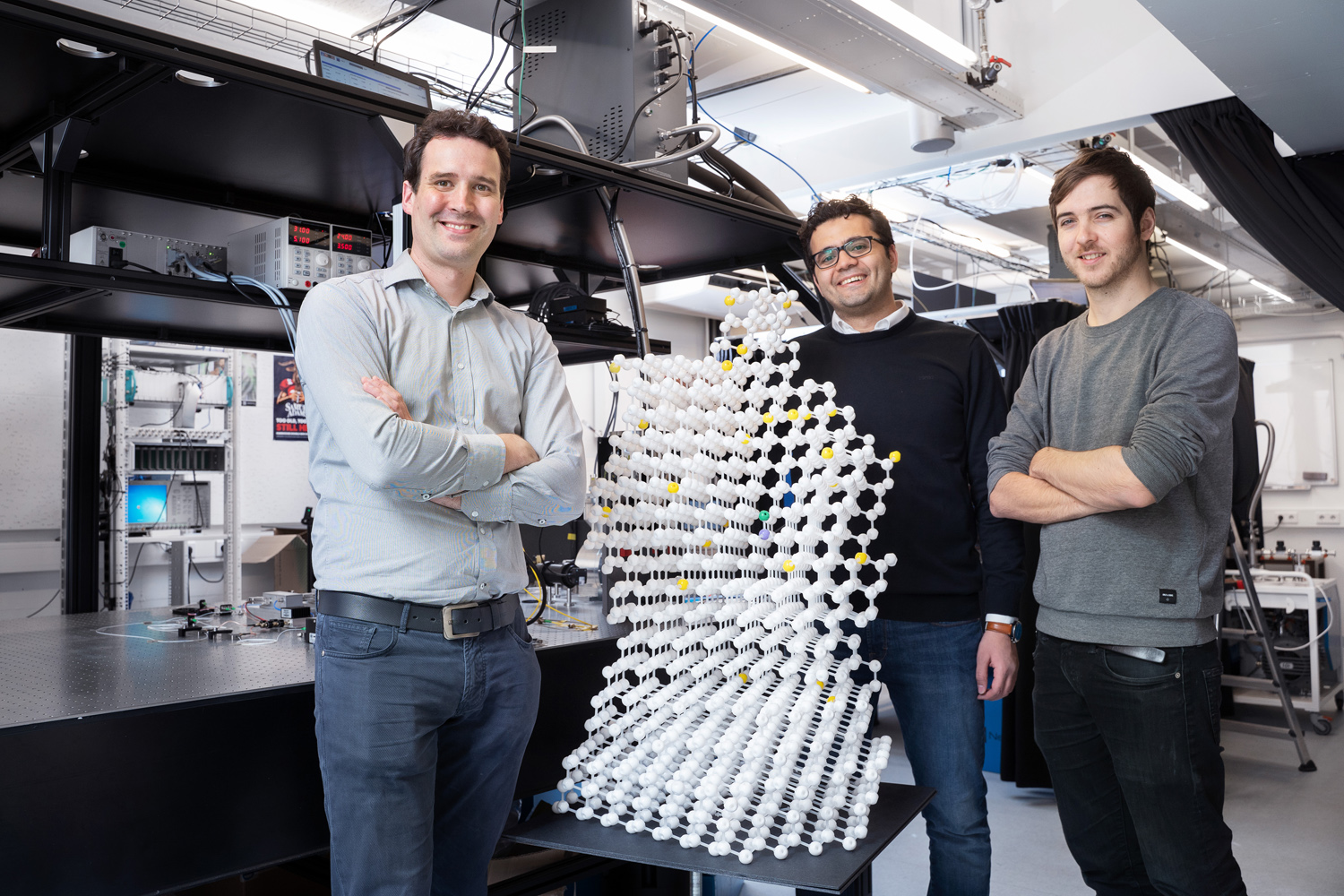After Microsoft and Intel, the Japanese computer company Fujitsu has now signed a cooperation agreement with QuTech. What does that mean for the research?
Tim Taminiau (left) with colleagues Mohamed Abobeih and Joe Randall with a molecule model of diamond with spin qubits. (Photo: Ernst de Groot | QuTech)
QuTech is working on developing four different types of quantum bits, or qubits, simultaneously. The development of super conducting quantum bits and quantum dots (in Dutch) in silicon is co-supported by the American chip manufacturer Intel. Microsoft is interested in the development of the elusive Majoranas as a quantum bit. And now the fourth variant, spin qubits in diamond, also has an industry partner – the Japanese electronics and computer manufacturer Fujitsu. The press release speaks of a ‘multi-year contract’, but the details are confidential.
Dr Tim Taminiau is QuTech’s group leader. QuTech is an alliance of TNO and TU Delft that is developing a quantum computer and quantum internet. In the international race to be the first to present a working quantum computer, QuTech is playing several fields at the same time, explains Taminiau.
What is the goal of the collaboration?
“We plan to design a modular quantum computer. We will then not only look at how we can produce the quantum bits, but also how we can embed them in a chip, how we can integrate everything and how we can build the computer architecture with all the electronics and cooling around it. On the longer term, this will provide the possibility to scale up the number of quantum bits.”.”
How many stable qubits can you form?
“We make a distinction between physical and logical quantum bits. A logical quantum bit is compiled from several physical qubits by using a type of quantum error correction. It is that composition that we want to develop in this project and to do that, we are looking at how to do error corrections in modular systems smartly and what you need to do this. We still don’t know how many usable logical qubits this will generate. Our goal is to eventually be at a stage where we know how to produce handleable logical qubits. If we can do this, we will have an idea about how we can build a larger system.”
Why is there an emphasis on modular building?
“We work on modules that are optically connected. This gives you the freedom to decide the distance you want between the qubits. You could, say, connect 50 qubits very close to each other and then place the next 50 a bit further apart and connect them optically so that they are separate from each other in independent modules. This helps you avoiding errors given that qubits influence each other. This leads us to believe that a modular system would be very scalable.”
Researchers want to publish while companies do not want to divulge their secrets. Does this not create tension in the collaboration?
“The goal is that the collaboration speeds up the scientific research. We have made agreements about how we can make sure that the research can be sped up while at the same time there is potential for future commercialisation for the parties involved. This is not new for QuTech. If something that has an economic value emerges from the research, we will patent it. We always do this, independent of industry collaboration. QuTech’s objective is to do research as well as to generate economic value for TU Delft, the Netherlands and Europe.”
And what is it that gives this form of qubit, spin quantum bits in diamond, so much potential?
“One important advantage of spin quantum bits in diamond is that they work at higher temperatures than super conducting qubits or Majoranas. Our qubits work up to 10 Kelvin. This may seem like a small difference compared to the millikelvins of other qubits, but in practice, it works much more easily.”
Do you have a question or comment about this article?
j.w.wassink@tudelft.nl


Comments are closed.